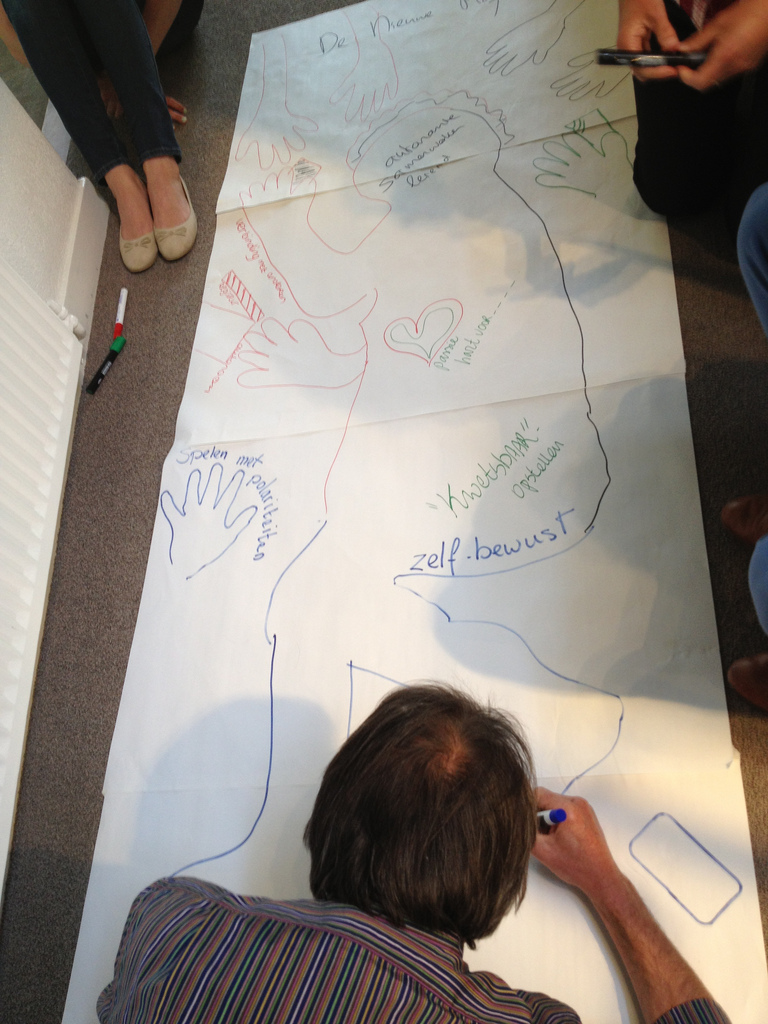 (foto hangop door Debra Solomon)
(foto hangop door Debra Solomon) What do you do if you want to prepare 'hangop' (see picture if you don't know what it is!)? Do you ask your neighbor, call your aunt or are you looking for information on the Internet? Friday's session about use of video for learning things showed that a mother look for it in a cookbook and her son looked on the Internet for a movie. The clever use of video was central, to our session: how can you use video in learning and education? The afternoon began with a conversation about changing use of video which immediately yielded new insights about the power and the important place of this medium:
- A student of high school fount a guy on youtube a guy who explains mathematics very well. This helps her understand it.
- How to tie your tie? : just search on Youtube for a convenient explanation.
- A special knife bought but ultimately not know how it works? Instead of reading the manual a movie will help you out.
 How can you use video in education or learning? From two case studies - one from higher educationcollege and another one from a government organization, we examined (and watched) how video is used in different ways. Annelies Ranzijn (see photo) shared the experiences of Inholland with weblectures and I shared the experience of En nu online with the use of video within an online learning program, together we covered a beautiful range from professional to amateuristic use of video and everything in between. Some examples of how you can use video:
How can you use video in education or learning? From two case studies - one from higher educationcollege and another one from a government organization, we examined (and watched) how video is used in different ways. Annelies Ranzijn (see photo) shared the experiences of Inholland with weblectures and I shared the experience of En nu online with the use of video within an online learning program, together we covered a beautiful range from professional to amateuristic use of video and everything in between. Some examples of how you can use video:- Weblectures of 5-7 minutes on general topics such as language.
- How to- instruction video, for example, how to change email subscription explained in 1 minute.
- Tedtalks
- Screencasts by experts or teachers using a powerpoint or prezi with explanations
- Recording Skype interviews and webinars so that others can watch them later
A number of lessons and observations from the two cases ... The interesting thing is that there are some lessons that are similar for both cases.
- For example, in both selected cases, a choice was made for videos of around 10 minutes or shorter. Inholland started by recording all lectures, but stopped this practices. In some cases, a choice is made for a slightly longer video like a TEDTalk of a maximum of 20 minutes.
- In both cases, a choice was made to work with own staff / teachers in the lead for designing and featuring in the videos, instead of professional actors or external persons. This increases the ownership and you make use of the existing knowledge from within the organization, which matches the context of the learning trajectory or module best. Not every teacher or professional is immediately excited to feature in a video, sometimes people do not feel secure enough to act in front of a camera or webcam. What you can do is start by inviting the people who are immediately excited for the new media and opportunities, then show the results to others and try to interest them as well. Producing a short weblecture requires you to know the core of your content.
- Video allows you to bring situations from outside the classroom inside (interviews from overseas via skype, filming on a building site), which make a good link to the practice possible.
- The learning outcomes of the videos is good. In both cases, watching the movies is optional, not mandatory. For example, in the language classes, students may also choose to join the class without viewing the videos. Participants indicate clearly that they learned from videos, albeit in combination with assignments and discussions (there is no final test). In higher education, the test results have gone up.
- Finally, the statistics of the number of times a video has been viewed have proven to be very useful to know what works.

